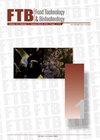Flavonoid Identification, Antioxidant and Antiproliferative Activity of Aqueous Infusions of Calendula officinalis L., Chelidonium majus L., Teucrium chamaedrys L. and Alchemilla vulgaris L.
IF 2.3
4区 农林科学
Q3 BIOTECHNOLOGY & APPLIED MICROBIOLOGY
引用次数: 0
Abstract
Research background. The current changes in the global economy, characterised by the climate crisis and the economic and health impact of the COVID-19 pandemic, have led to a significant demand for medicinal herbs. This trend is expected to increase significantly by 2050. In this study, we investigated the biopotential of aqueous infusions of four medicinal plants: Calendula officinalis, Chelidonium majus, Teucrium chamaedrys, and Alchemilla vulgaris. Experimental approach. The flavonoid analysis of the aqueous infusions of selected plants was carried out using the RP-HPLC technique. The antiproliferative activity of the prepared aqueous plant infusions was analysed against three human cancer cell lines (MDA-MD-231, T24, and A549), while the antioxidant potential was measured using three antioxidant methods (DPPH, FRAP, and Rancimat assay). Results and conclusions. T. chamaedrys had highest total phenolics (2061.20±42.36 mg GAE/L), free radical scavenging activity (IC50 = 1.9 mg/mL) and ferrous reducing antioxidant power (9797.82±26.96 mg FeCl2/L). At a concentration of 1 mg/mL, the antiproliferation of T24 by C. majus was as high as 96 %, and of MDA-MD-231 cells by A. vulgaris 75 % after 72 h. After principal component analysis, T. chamaedrys and C. majus were grouped together. Quercetin-glucoside and antioxidant capacity (DPPH) contributed the most to separate these infusions from the other two. Novelty and scientific contribution. This study represents a comparative analysis of the biopotential of four medicinal plants. A new RP-HPLC method was developed to separate the flavonoids in the herbal infusions. This is the first report on kaempferol-3-O-rutinoside in C. officinalis, and isorhamnetin-3-O-rutinoside in A. vulgaris aqueous infusion. For the first time, C. majus was shown to contribute to the oxidative stability of edible oil. Furthermore, this is the first comparative study on the antiproliferative activity of selected medicinal plants against the cell lines MDA-MD-231, T24 and A549.金盏花、大叶诃子、柚木和紫苏水溶液的类黄酮鉴定、抗氧化和抗增殖活性
研究背景。当前全球经济的变化以气候危机和 COVID-19 大流行病对经济和健康的影响为特征,导致了对药草的大量需求。预计到 2050 年,这一趋势将大幅增加。在这项研究中,我们调查了四种药用植物水溶液的生物潜力:实验方法。实验方法。采用 RP-HPLC 技术对所选植物的水溶液进行黄酮类化合物分析。分析了制备的植物水溶液对三种人类癌细胞株(MDA-MD-231、T24 和 A549)的抗增殖活性,并使用三种抗氧化方法(DPPH、FRAP 和 Rancimat 分析法)测量了抗氧化潜力。结果和结论T. chamaedrys 具有最高的总酚(2061.20±42.36 mg GAE/L)、自由基清除活性(IC50 = 1.9 mg/mL)和亚铁还原抗氧化能力(9797.82±26.96 mg FeCl2/L)。在 1 mg/mL 的浓度下,72 小时后,C. majus 对 T24 细胞的抗增殖率高达 96%,A. vulgaris 对 MDA-MD-231 细胞的抗增殖率为 75%。槲皮素-葡萄糖苷和抗氧化能力(DPPH)是将这些输液与其他两种输液区分开来的最大因素。新颖性和科学贡献。本研究对四种药用植物的生物潜力进行了比较分析。研究人员开发了一种新的 RP-HPLC 方法,用于分离草药浸剂中的黄酮类化合物。这是首次报道山奈酚-3-O-芸香糖苷和异鼠李素-3-O-芸香糖苷。研究首次表明,大叶女贞有助于提高食用油的氧化稳定性。此外,这是首次比较研究选定药用植物对细胞系 MDA-MD-231、T24 和 A549 的抗增殖活性。
本文章由计算机程序翻译,如有差异,请以英文原文为准。
求助全文
约1分钟内获得全文
求助全文
来源期刊

Food Technology and Biotechnology
工程技术-生物工程与应用微生物
CiteScore
3.70
自引率
0.00%
发文量
33
审稿时长
12 months
期刊介绍:
Food Technology and Biotechnology (FTB) is a diamond open access, peer-reviewed international quarterly scientific journal that publishes papers covering a wide range of topics, including molecular biology, genetic engineering, biochemistry, microbiology, biochemical engineering and biotechnological processing, food science, analysis of food ingredients and final products, food processing and technology, oenology and waste treatment.
The Journal is published by the University of Zagreb, Faculty of Food Technology and Biotechnology, Croatia. It is an official journal of Croatian Society of Biotechnology and Slovenian Microbiological Society, financed by the Croatian Ministry of Science and Education, and supported by the Croatian Academy of Sciences and Arts.
 求助内容:
求助内容: 应助结果提醒方式:
应助结果提醒方式:


